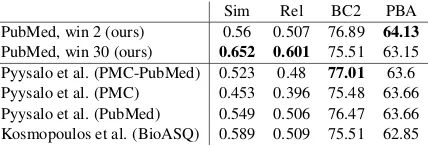How to Train good Word Embeddings for Biomedical NLP
Full text
Figure




Related documents
leaf MeOH extracts is effective through 30 mg/ml to 100mg/ml concentration while the methanolic callus extract is effective at all the concentrations for most of the
Factors influencing the capacity for guideline implementation will be explored among a relatively small sample of par- ticipants in Ontario, Canada so those findings may not be
traditional approaches, as in case of Tarbela Reservoir it can be performed in one week, instead of four weeks in old approach. Similarly, data analysis and interpretation can
60,74,75 With recent advances in nanotechnology, nanostructured materi- als have emerged as novel orthopedic implants with greater potential to provide osseointegration while
This study shows that the Sindbis double subgenomic viral vector, which has been engineered successfully to direct mosquito cells to express green fluorescent protein, also will
C, Cine PC MR image (52.0/15.8/1) on the day after the third ventriculostomy shows continuous (patent) flow from the prepontine cistern to the third ventricle, inferior to superior
The following relationships were analyzed using a one-tailed t-test: propulsive wavelength as a function of driving frequency and Young’s modulus; tail-beat amplitude as a function
The sperm-amotile gene is required for male fertility, and the dunce gene is required for normal learning, female fer- tility, and CAMP-specific phosphodiesterase

